We’ve all experienced those restless nights where sleep feels impossible and our bedroom energy seems completely off. Feng shui transforms your bedroom into a sanctuary that promotes deep rest and positive energy flow through strategic placement and mindful design choices.
The ancient Chinese practice of feng shui isn’t just about moving furniture around—it’s about creating harmony between you and your environment. When we apply feng shui principles to our bedrooms we’re optimizing the space where we spend nearly one-third of our lives for maximum comfort and rejuvenation.
From positioning your bed for optimal chi flow to choosing colors that enhance tranquility we’ll explore practical feng shui bedroom ideas that anyone can carry out. These time-tested techniques will help you create a peaceful retreat that supports better sleep improved relationships and overall well-being.
Create a Peaceful Sleep Sanctuary With Proper Bed Placement
Strategic bed positioning forms the foundation of feng shui bedroom design and directly impacts our sleep quality and overall well-being.
Position Your Bed in the Command Position
Command position places your bed diagonally across from the bedroom door while maintaining a clear view of the entrance. This arrangement allows us to see who enters our sleeping space without being directly aligned with the doorway. We recommend positioning the headboard against a solid wall with enough space to walk around both sides of the bed.
Diagonal placement creates optimal energy flow around our sleeping area. Energy moves more smoothly when it doesn’t rush directly from the door toward our resting bodies. We suggest measuring at least 18 inches of clearance on each side of the bed to promote balanced chi circulation.
Clear sightlines to the door provide psychological security during rest. Our subconscious minds remain alert when we can’t monitor the room’s entrance. We feel more relaxed and sleep deeper when positioned where we naturally observe our bedroom’s main access point.
Avoid Placing Your Bed Under Windows or Beams
Windows above our headboard create unstable energy that disrupts restful sleep patterns. External light and sounds penetrate through glass barriers and interfere with our natural circadian rhythms. We lose vital energy when sleeping directly beneath window openings that allow chi to escape during nighttime hours.
Overhead beams generate oppressive downward pressure on our resting bodies. Exposed structural elements create energetic weight that can cause headaches and restless sleep over time. We recommend relocating beds away from ceiling beams or installing fabric canopies to deflect heavy architectural influences.
Alternative positioning options include moving beds to interior walls or corners. Interior walls provide stable backing without external disturbances from weather or street activity. We find that corner placements often offer the most protected sleeping environments while maintaining command position benefits.
Ensure Solid Wall Support Behind Your Headboard
Solid walls behind our headboard provide essential energetic backing for deep sleep. Sturdy support creates psychological stability that helps our nervous systems relax completely during rest periods. We need substantial backing to feel fully secure while in our most vulnerable sleeping state.
Shared walls with bathrooms or kitchens should be avoided when possible. Water and fire elements from adjacent rooms can disrupt our bedroom’s peaceful energy balance. We recommend choosing walls that border quiet spaces like closets or other bedrooms for optimal rest conditions.
Headboard attachment to walls creates additional stability and grounding energy. Firmly mounted headboards prevent shifting that can disturb our sleep and create energetic instability. We suggest using wall brackets or direct mounting systems to secure headboards against their supporting walls for maximum feng shui benefits.
Choose Calming Colors That Promote Restful Sleep

Color selection plays a crucial role in creating the peaceful atmosphere that feng shui bedroom design requires. We can transform our sleeping space into a sanctuary of tranquility by choosing hues that support restful energy flow.
Incorporate Earth Tones and Neutral Shades
Earth tones create the foundation for a peaceful bedroom environment that promotes deep relaxation. Latte, off-white, and cocoa shades work particularly well as they ground the space and encourage serenity. These neutral colors connect us to natural elements while maintaining the balanced energy that feng shui principles emphasize.
Beige walls paired with warm taupe bedding establish a soothing base that won’t overstimulate our senses. Mushroom gray offers another excellent option for those seeking a sophisticated yet calming palette. Sand colored accents through throw pillows or curtains can add warmth without disrupting the peaceful atmosphere we’re cultivating.
Add Soft Pastels for Gentle Energy Flow
Soft pastels enhance the calming atmosphere while promoting gentle energy circulation throughout our bedroom space. Pale lavender encourages relaxation and can help reduce stress levels after long days. Dusty rose brings a touch of warmth while maintaining the serene quality that supports quality sleep.
Sage green connects us to nature’s healing properties and creates a refreshing yet peaceful environment. Powder blue evokes the tranquility of clear skies and calm waters. We can incorporate these gentle hues through wall paint, bedding, or decorative elements to create layers of soothing color.
Avoid Bright Reds and Stimulating Colors
Bright red disrupts the peaceful energy flow that our bedroom requires for optimal rest and rejuvenation. This stimulating color can increase heart rate and create mental alertness when we need our minds to wind down. Orange and vibrant yellow similarly activate our nervous system rather than promoting the calm state necessary for deep sleep.
Electric blue and neon green should also be eliminated from our bedroom color scheme as they can interfere with our natural sleep cycles. Hot pink and bright purple create energetic vibrations that conflict with the restorative atmosphere we’re trying to achieve. Instead of these stimulating shades, we should focus on the earth tones and soft pastels that support our feng shui bedroom goals.
Declutter Your Space for Positive Energy Flow
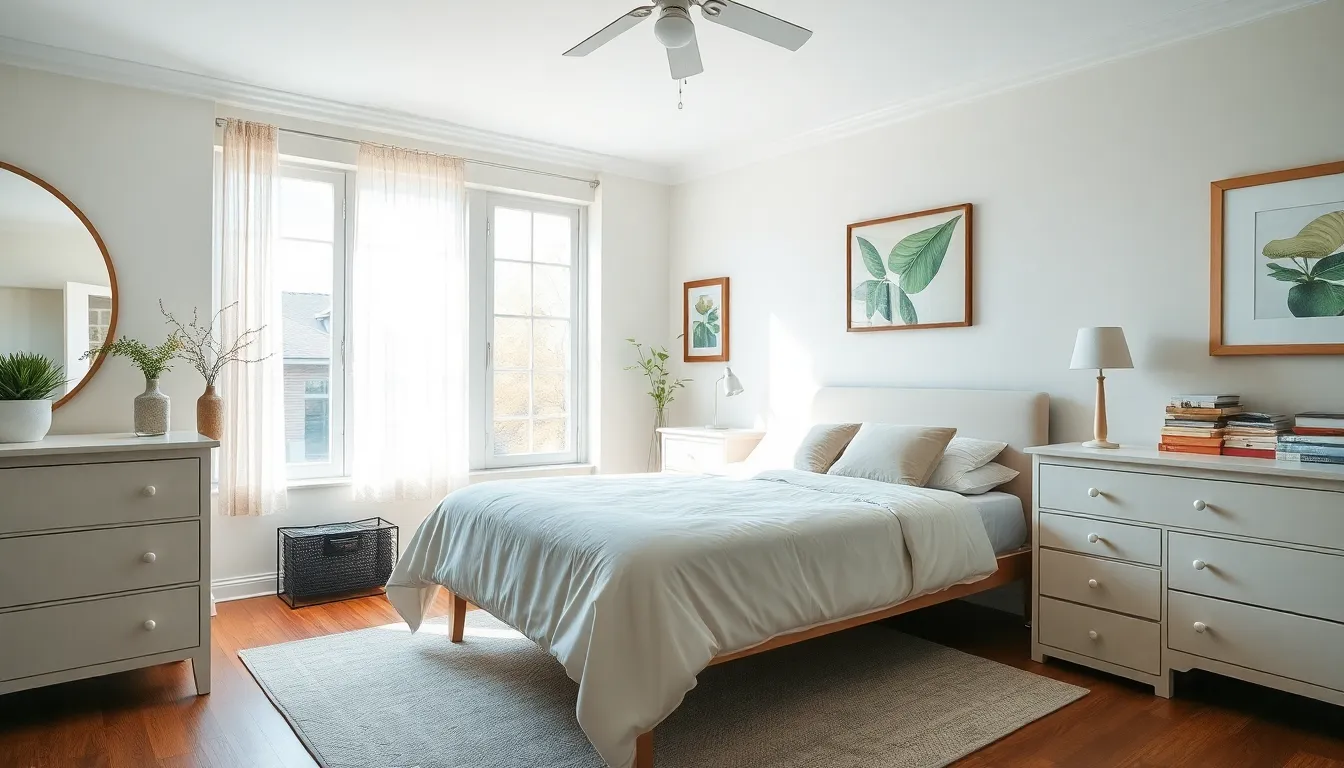
We need to create clear pathways for chi to circulate freely throughout our bedroom space. Removing unnecessary items maintains the harmonious energy balance that’s essential for restful sleep and overall well-being.
Remove Electronics and Work-Related Items
Electronics generate active, energetic disruptions that interfere with our bedroom’s peaceful atmosphere. Feng shui experts consistently recommend keeping televisions, computers, tablets, and smartphones away from sleeping areas to reduce mental stimulation. Work materials like laptops, paperwork, and office supplies create stressful associations that prevent our minds from transitioning into rest mode.
We should designate our bedroom as a technology-free sanctuary where digital distractions can’t compromise our sleep quality. Charging stations work best when placed outside the bedroom, allowing us to disconnect completely from work and social media pressures. This practice supports the calm, restorative environment that feng shui principles emphasize for optimal rest.
Clear Under-Bed Storage Areas
Storage beneath our bed creates subconscious tension and impedes the natural flow of energy around our sleeping space. Chi needs to circulate freely underneath the bed to enhance relaxation and support positive sleep energy throughout the night. Items stored in this area can create energetic blockages that manifest as restless sleep or morning fatigue.
We benefit most when we keep the under-bed space completely clear, allowing energy to move smoothly around our entire sleeping area. Boxes, shoes, and seasonal items should find storage locations elsewhere in our home to maintain this crucial energy pathway. The unrestricted flow of chi beneath our bed contributes significantly to deeper, more restorative sleep patterns.
Organize Closets and Dressers Regularly
Maintaining organized closets and dressers ensures that our belongings stay neatly arranged and efficiently stored throughout our bedroom space. Regular organization prevents the accumulation of visual chaos that can contribute to stress and mental unrest in our sleeping environment. We create a sense of order and calm when we dedicate time to sorting, folding, and arranging our clothing and personal items.
Systematic maintenance keeps energy fresh and prevents stagnant chi from building up in storage areas. Seasonal cleanouts help us evaluate what we truly need while removing items that no longer serve our current lifestyle. This ongoing practice supports the balanced, harmonious environment that feng shui tradition emphasizes for health, relationships, and quality sleep.
Balance the Five Elements in Your Bedroom Design

Creating harmony in your bedroom requires balancing the Five Elements of feng shui: Wood, Fire, Earth, Metal, and Water. We’ll focus on incorporating Wood, Metal, and Earth elements to establish a foundation of stability and growth in your sleeping space.
Introduce Wood Elements Through Natural Materials
Wood elements promote growth and harmony while supporting our body’s natural healing processes during sleep. We can incorporate solid wood furniture pieces like nightstands, dressers, or bed frames to establish this grounding energy. Woven baskets serve as both functional storage answers and natural wood element enhancers that maintain the room’s organic flow.
Plants bring living wood energy into our bedrooms, though we should choose varieties that release oxygen at night like snake plants or peace lilies. Wooden picture frames, bamboo blinds, or reclaimed wood accent walls add visual warmth while strengthening the wood element’s presence. Natural fiber rugs made from jute, hemp, or cotton provide underfoot comfort while reinforcing our connection to organic materials.
Add Metal Accents With Decorative Objects
Metal elements enhance clarity and focus, supporting our mind’s ability to release daily stress and embrace restful sleep. We can introduce metal through decorative vases, picture frames, or small sculptures that complement our bedroom’s existing color palette. Wind chimes positioned near windows create gentle sounds that activate metal energy while promoting peaceful transitions between day and night.
Brass or copper accent pieces like table lamps, drawer pulls, or decorative bowls add sophisticated metal touches without overwhelming the space. Silver or white gold jewelry displays on elegant stands serve dual purposes as organization tools and metal element activators. We should balance metal accents carefully, using them as supporting elements rather than dominant features in our bedroom design.
Include Earth Elements With Crystals and Stones
Earth elements ground our space and promote stability, creating the secure foundation necessary for deep, restorative sleep. We can incorporate crystals and stones through carefully selected pieces like amethyst for calming energy, rose quartz for love and relationships, or clear quartz for clarity and peace. Natural stone accessories such as ceramic vases, clay sculptures, or terra cotta planters add earthy textures that support our bedroom’s grounding energy.
Himalayan salt lamps provide both earth element presence and gentle lighting that doesn’t disrupt our natural sleep rhythms. Stone coasters, geode bookends, or small rock gardens positioned on nightstands or dressers reinforce the earth element’s stabilizing influence. We should choose earth elements that resonate with our personal energy while maintaining the bedroom’s overall sense of tranquility and balance.
Optimize Natural Light and Air Circulation

Natural light and fresh air form the foundation of healthy energy flow in feng shui bedroom design. These essential elements work together to create an environment that supports both physical wellness and spiritual harmony.
Use Sheer Curtains for Gentle Light Filtering
Sheer curtains transform harsh sunlight into soft, nurturing illumination that promotes balanced energy throughout your bedroom. These lightweight window treatments allow natural light to filter gently into the space while maintaining privacy and creating a calming ambiance. Installing sheer panels helps you control the intensity of incoming light without completely blocking the sun’s beneficial energy.
We recommend choosing neutral tones like cream, white, or pale pastels for your sheer curtains to complement the earth tones and neutral shades already established in your feng shui color palette. Layering sheers with heavier drapes gives you flexibility to adjust light levels throughout the day. Natural fabrics such as linen or cotton enhance the organic feel while supporting the Wood element in your five element balance.
Position Mirrors to Reflect Natural Light Wisely
Mirrors amplify natural light and expand the sense of space when positioned strategically in feng shui bedrooms. Placing mirrors to reflect natural light from windows helps brighten darker corners while improving the overall energy distribution throughout the room. Strategic mirror placement can double the impact of your filtered sunlight without overwhelming the peaceful atmosphere you’ve created.
We suggest avoiding mirrors that directly reflect the bed, as this can disrupt sleep and create restless energy patterns. Instead, position mirrors on side walls or in areas where they’ll catch and redirect natural light toward reading nooks or dressing areas. Round or oval mirrors work particularly well as they promote gentle energy circulation compared to sharp rectangular edges.
Maintain Fresh Air Flow With Proper Ventilation
Fresh air circulation prevents stagnant energy from accumulating in your bedroom while supporting the overall health benefits of your feng shui design. Proper ventilation ensures clean oxygen flow that enhances sleep quality and maintains the energetic balance you’ve established through careful furniture placement and decluttering. Opening windows regularly allows negative energy to escape while inviting positive chi into your space.
We recommend installing ceiling fans or air purifiers if natural ventilation isn’t sufficient in your bedroom layout. Plants that release oxygen at night, such as snake plants or peace lilies, complement your ventilation efforts while reinforcing the Wood element in your five element harmony. Cross ventilation between two windows creates the most effective air movement patterns for optimal feng shui energy flow.
Incorporate Paired Items for Relationship Harmony
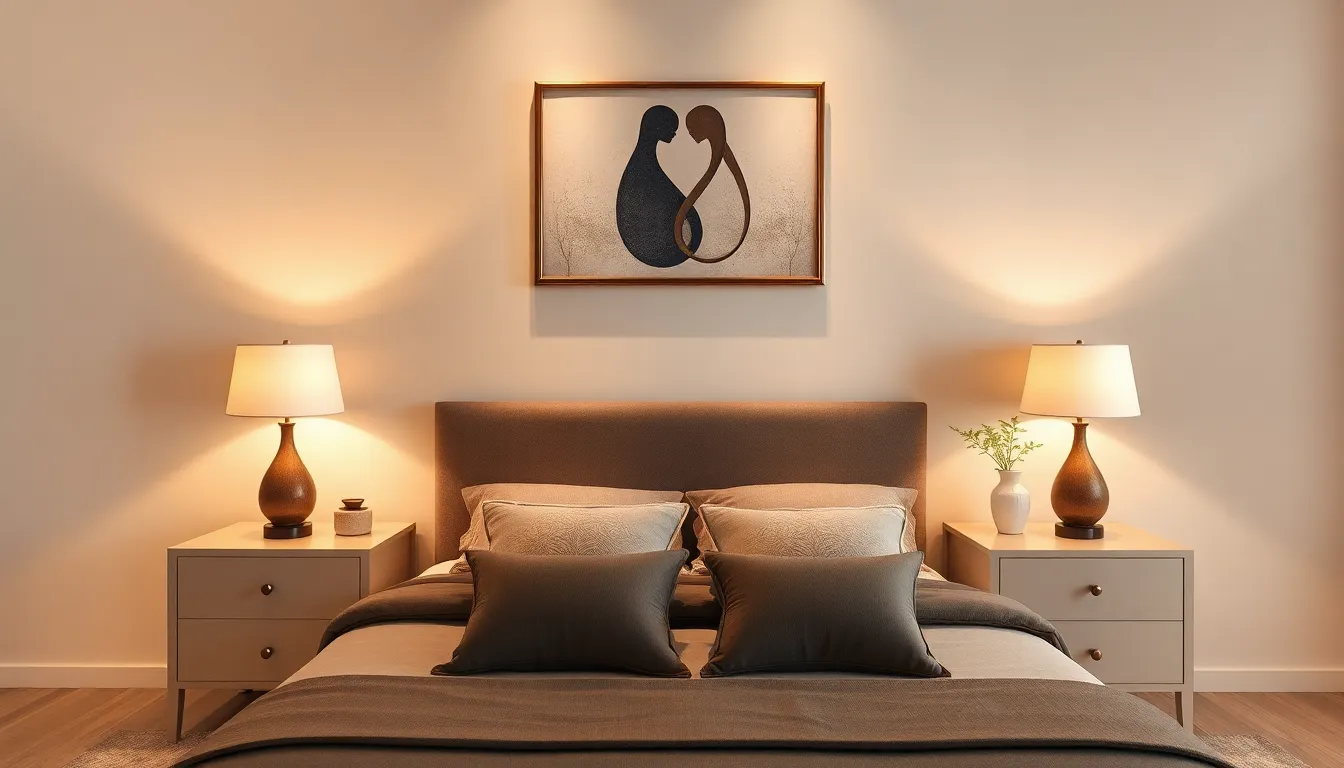
Creating balance through paired elements strengthens the romantic energy in your bedroom and supports deeper connection between partners. This feng shui principle works by establishing visual symmetry that promotes harmony and unity in relationships.
Display Matching Nightstands and Table Lamps
Matching nightstands serve as the foundation for relationship balance in feng shui bedroom design. We recommend choosing identical pieces that create perfect symmetry on either side of your bed, establishing equal partnership energy. Table lamps should mirror each other in both style and height to maintain the harmonious flow of energy between sleeping areas.
Position these paired elements at the same distance from your bed to ensure balanced chi distribution. Wooden nightstands work particularly well as they incorporate the Wood element while providing stable grounding energy for relationships. Choose lamps with soft, warm lighting that creates a romantic ambiance without overwhelming the peaceful bedroom atmosphere.
Choose Artwork That Depicts Pairs or Unity
Artwork featuring pairs creates powerful visual reminders of connection and togetherness in your bedroom space. We suggest selecting pieces that show two birds, intertwined figures, or couples enjoying peaceful moments together. These images reinforce the energy of partnership and help attract or strengthen romantic bonds.
Position paired artwork above your headboard or on the wall directly across from your bed where you can see it daily. Avoid single figure artwork or images that depict loneliness, as these can unconsciously influence relationship energy. Natural scenes featuring two trees growing together or paired flowers also work beautifully to enhance unity energy.
Add Symmetrical Decorative Elements
Symmetrical decorative elements amplify the balanced energy necessary for harmonious relationships throughout your bedroom. We recommend placing matching vases, sculptures, or decorative objects on both sides of your room to create visual equilibrium. Mirrors positioned symmetrically can expand positive energy while doubling the romantic symbolism of your paired items.
Consider adding matching plants in identical containers to introduce living energy that grows and flourishes like healthy relationships. Crystal pairs, such as rose quartz or amethyst, work exceptionally well on nightstands to promote love energy while maintaining the essential symmetry. These elements should complement your existing color palette while reinforcing the paired theme throughout your feng shui bedroom design.
Select Furniture With Rounded Edges and Soft Lines
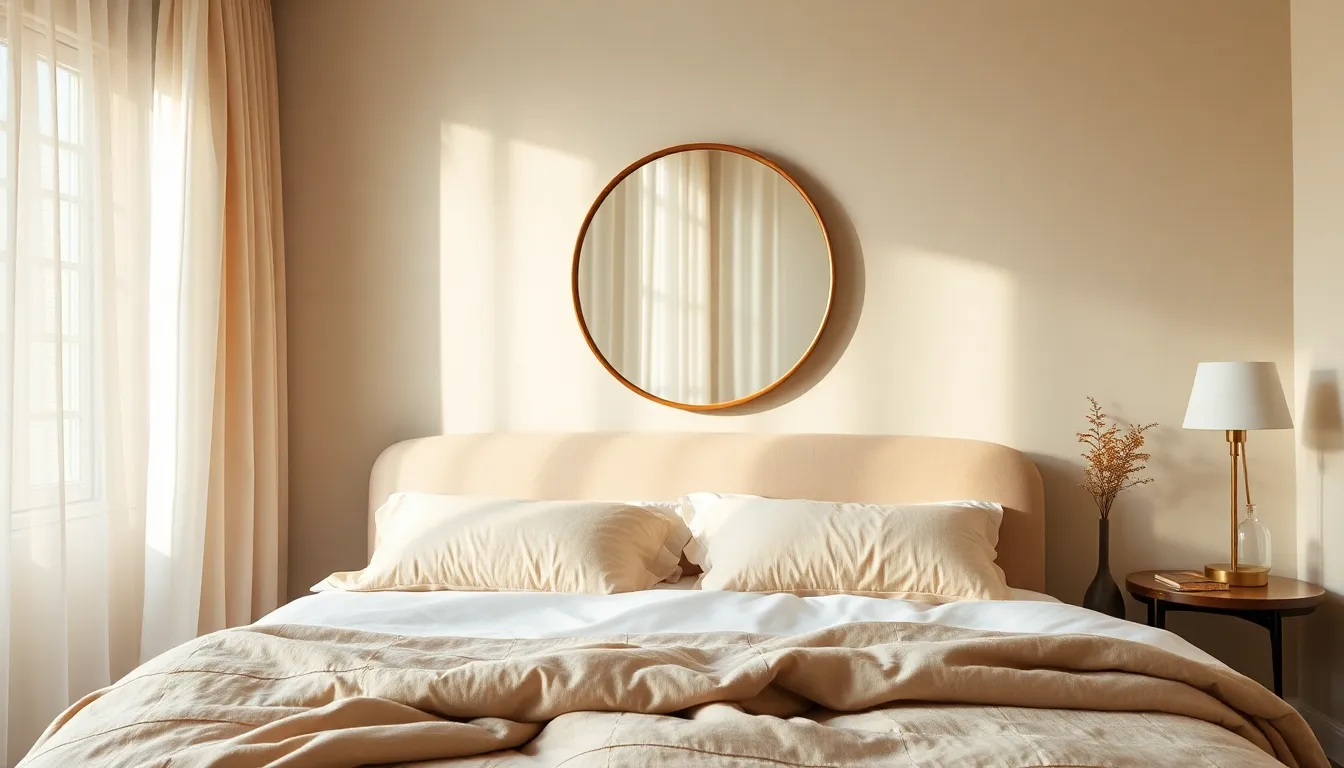
Sharp corners and angular furniture can create harsh energy flows that disrupt peaceful sleep. Curved and soft lined pieces allow chi to move smoothly throughout our bedroom space.
Choose Curved Headboards Over Sharp Angles
Curved headboards enhance the flow of energy around our sleeping area while creating a more nurturing environment. Rectangular headboards with sharp corners can generate cutting energy that interferes with restful sleep patterns. Selecting headboards with gentle curves or rounded tops helps soften the overall bedroom atmosphere.
Upholstered headboards with curved designs provide both comfort and aesthetic appeal while supporting feng shui principles. Arched headboards create a protective cocoon effect that makes us feel more secure during sleep. Avoid headboards with pointed or angular details that can create visual tension in our personal sanctuary.
Opt for Oval or Round Mirrors
Oval and round mirrors soften the space and avoid creating sharp reflections that can disturb bedroom harmony. Square or rectangular mirrors with hard edges can generate harsh energy that conflicts with the peaceful atmosphere we’re cultivating. Positioning circular mirrors away from direct bed reflection helps maintain positive energy flow.
Round mirrors symbolize wholeness and unity in feng shui practice while adding gentle light reflection to our space. Oval shaped mirrors provide elongated reflection without the aggressive energy of sharp cornered alternatives. Consider placing these softer mirror shapes on walls perpendicular to the bed rather than directly opposite it.
Include Soft Textiles and Fabrics
Soft textiles and fabrics promote relaxation and serenity while adding tactile comfort to our feng shui bedroom design. Plush throws, velvet cushions, and silk pillowcases create layers of gentle texture that invite rest and tranquility. Natural fibers like cotton, linen, and bamboo enhance the organic energy flow throughout our sleeping space.
Flowing curtains made from lightweight materials allow energy to move freely while maintaining privacy and light control. Layering different fabric textures creates visual depth without overwhelming the peaceful atmosphere we’ve established. Avoid stiff or scratchy materials that can create energetic resistance and discomfort in our restful sanctuary.
Add Living Plants for Natural Energy Enhancement
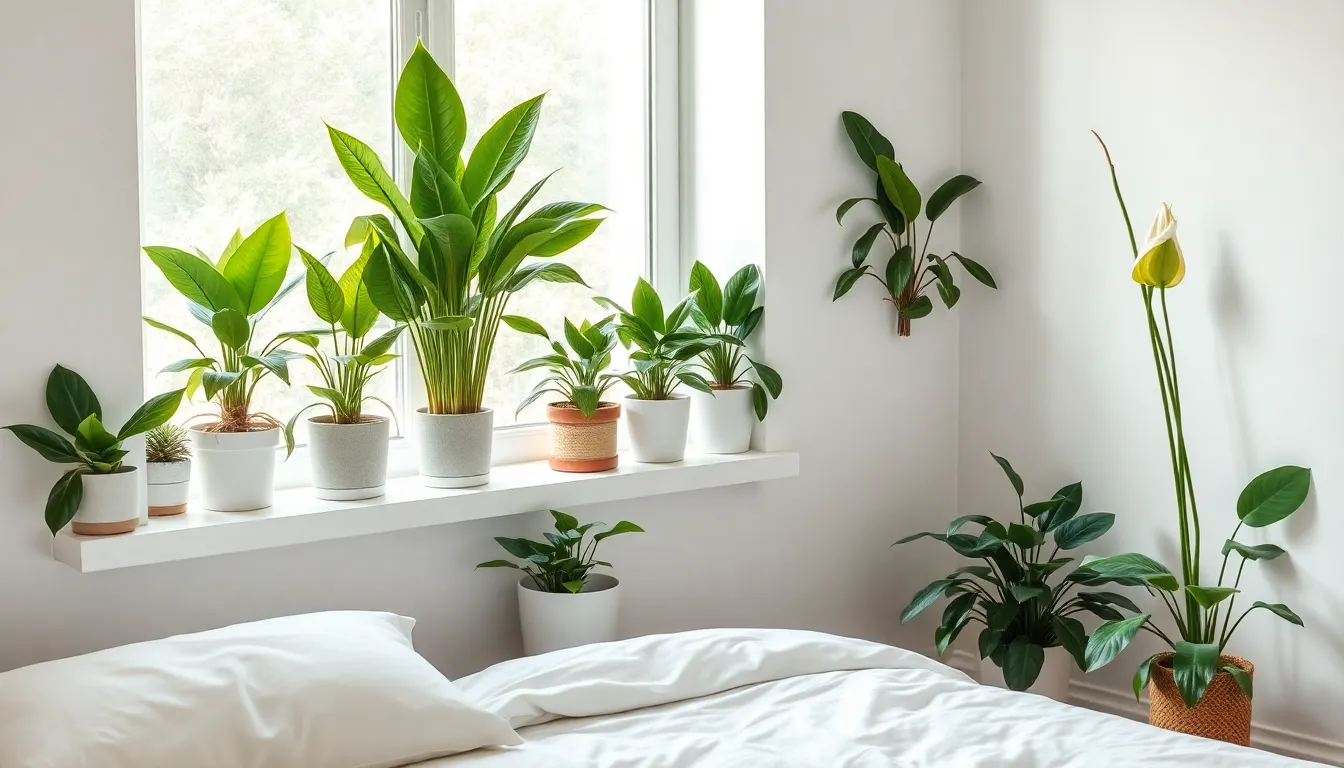
Plants bring the vital wood element into our bedroom space, fostering growth and flexibility while improving the natural energy flow that supports restful sleep.
Choose Low-Maintenance Plants for Beginners
Snake plants offer the perfect starting point for bedroom feng shui because they’re incredibly hardy and require minimal watering. These resilient plants can thrive in low light conditions and actually release oxygen at night, making them ideal for sleep spaces. Spider plants present another excellent beginner option with their air-purifying qualities and ability to adapt to various lighting conditions.
Pothos vines work wonderfully for those new to plant care since they can survive occasional neglect and still maintain their lush appearance. We recommend selecting plants that won’t stress you out with complicated care routines, as this defeats the purpose of creating a calming environment.
Position Plants Away From the Bed Area
Placing plants at least three feet from your bed prevents their upward and expansive energy from disrupting sleep patterns. This distance allows you to enjoy the wood element’s benefits without overwhelming your rest space with too much active energy. Corner placement works particularly well for larger plants, as they can enhance the room’s energy flow without interfering with your nightly routine.
Window sills provide an ideal location for smaller plants, where they can receive natural light while maintaining appropriate distance from the sleeping area. We suggest avoiding plants directly on nightstands or the dresser closest to your bed to maintain the serene energy essential for quality rest.
Select Plants That Purify Air Quality
Peace lilies excel at removing toxins from bedroom air while adding elegant white blooms that complement neutral feng shui color schemes. These plants can thrive in low light conditions and indicate their watering needs through slight leaf drooping. Boston ferns create a lush, natural atmosphere while actively filtering harmful chemicals from the air throughout the night.
Rubber plants serve as excellent air purifiers with their large, glossy leaves that can remove formaldehyde and other common indoor pollutants. We recommend choosing plants with documented air-cleaning properties to maximize both the feng shui benefits and the health advantages they bring to your sleep sanctuary.
Create Intimate Lighting for Evening Relaxation
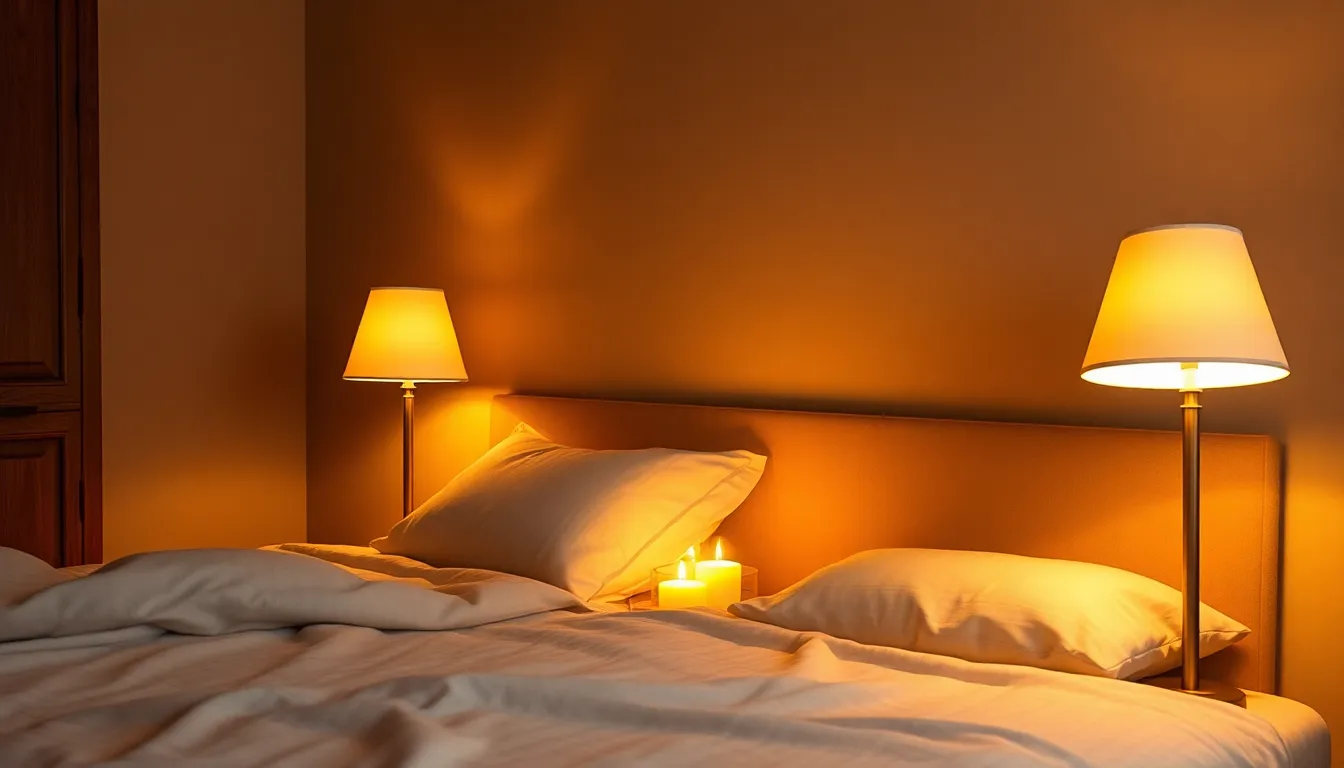
Proper lighting transforms your bedroom into a peaceful sanctuary that supports both sleep and romance. We’ll explore how strategic lighting choices can enhance your feng shui bedroom’s energy flow while creating the perfect atmosphere for relaxation.
Install Dimmer Switches for Adjustable Ambiance
Dimmer switches give you complete control over your bedroom’s lighting intensity throughout the day. Installing these versatile controls allows you to create bright illumination for morning routines and gentle lighting for evening wind-down rituals.
Adjustable lighting supports your body’s natural circadian rhythms by gradually reducing brightness as bedtime approaches. Dimmers work particularly well with overhead fixtures, allowing you to maintain the functionality of existing lights while improving their feng shui benefits.
Position dimmer controls within easy reach of your bed for convenient evening adjustments. This placement ensures you can modify the lighting without getting up, maintaining the peaceful energy flow in your space.
Use Table Lamps Instead of Harsh Overhead Lighting
Table lamps provide softer, more intimate lighting that promotes relaxation and peaceful energy. These fixtures create pools of warm light that feel welcoming and cozy compared to bright overhead illumination.
Place matching table lamps on both nightstands to maintain visual balance and support relationship harmony. This symmetrical arrangement follows feng shui principles while ensuring both partners have adequate reading light.
Choose lampshades in neutral tones like cream, beige, or warm white to complement your existing color palette. These shades filter light gently, creating a soothing atmosphere that encourages rest and tranquility.
Consider lamps with warm LED bulbs that emit soft, golden light rather than cool white illumination. This warmer light temperature helps signal to your body that it’s time to prepare for sleep.
Add Candles for Romantic Feng Shui Energy
Candles enhance the romantic feng shui energy in your bedroom while creating a cozy, intimate setting. Their flickering flames represent the fire element, bringing warmth and passion to your space when used thoughtfully.
Select candles in earth tones or neutral colors that align with your bedroom’s overall color scheme. Avoid overly bright or stimulating colors that might disrupt the calm energy you’ve cultivated throughout the room.
Group candles in odd numbers like three or five to create visual interest and positive energy flow. Place them on surfaces away from curtains, bedding, and other flammable materials to ensure safety.
Battery operated candles offer a safer alternative while still providing the warm, flickering light that enhances romantic energy. These options eliminate fire hazards while maintaining the peaceful ambiance that supports intimate moments and deep relaxation.
Remove or Reposition Mirrors for Better Sleep Quality
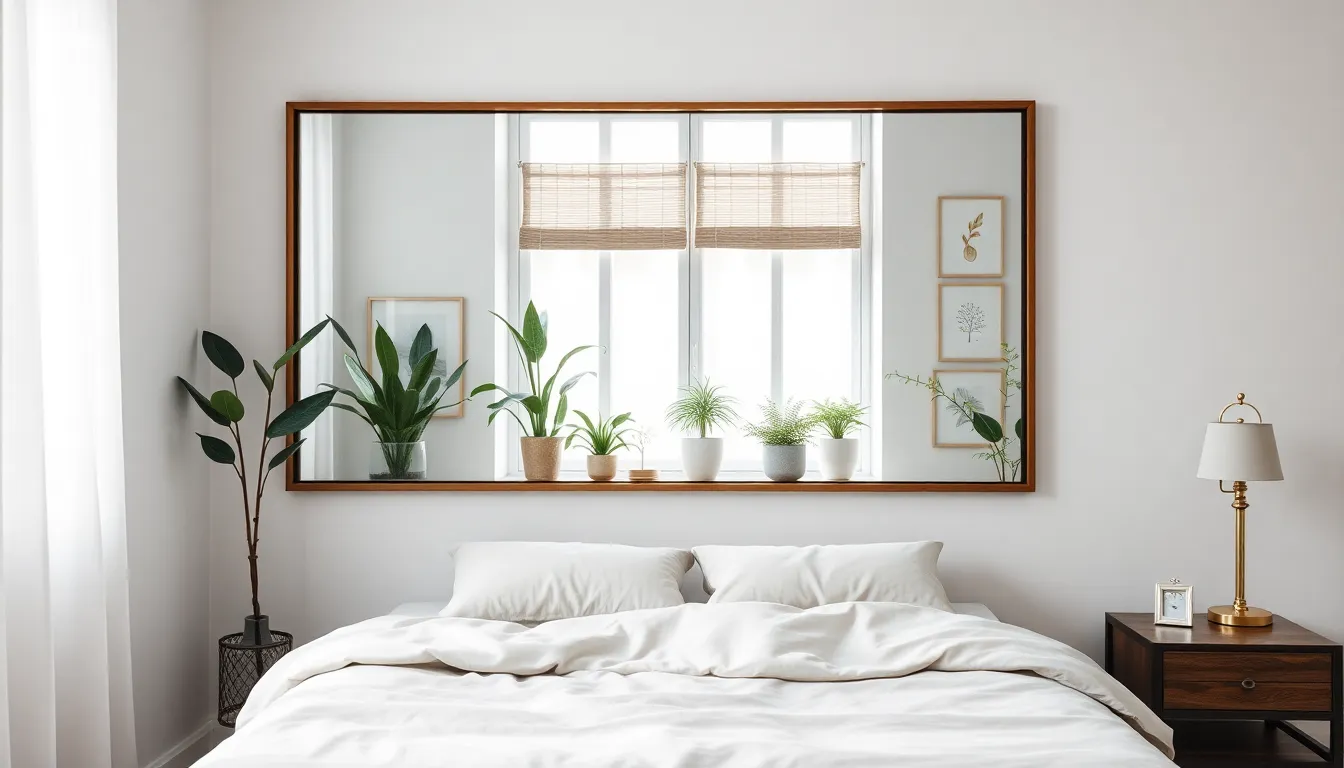
Mirrors can significantly disrupt your bedroom’s feng shui energy flow and compromise sleep quality when positioned incorrectly. Strategic mirror placement allows you to harness their space-improving benefits while maintaining the peaceful sanctuary your bedroom should provide.
Avoid Mirrors Directly Facing the Bed
Positioning mirrors to directly face your bed creates an energetic disturbance that can interfere with restful sleep patterns. The reflection of your sleeping form generates active energy during hours when your body needs to rest and restore itself naturally.
We recommend checking all mirror angles in your bedroom to ensure none reflect your bed directly. Large dresser mirrors often pose the biggest challenge since they’re typically positioned at eye level and can easily capture bed reflections.
Moving existing mirrors to adjacent walls eliminates direct bed reflections while maintaining their decorative value. Consider angling mirrors slightly away from the bed if repositioning isn’t possible due to furniture constraints.
Place Mirrors to Expand Space Strategically
Strategic mirror placement can enhance your bedroom’s spaciousness without disrupting sleep energy when positioned thoughtfully. Mirrors work best when they reflect windows, doorways, or beautiful views rather than sleeping areas.
We suggest placing mirrors on walls perpendicular to your bed to expand the room’s visual dimensions. This positioning allows natural light to bounce throughout the space while keeping reflective energy away from your rest area.
Positioning mirrors to reflect artwork, plants, or decorative elements doubles their positive visual impact. Avoid placing mirrors where they’ll reflect clutter, electronics, or bathroom doorways, as these reflections can introduce chaotic energy into your peaceful space.
Cover Large Mirrors During Sleep Hours
Covering substantial mirrors during nighttime hours prevents energy reflection that can disturb your sleep cycles. Large mirrors continue to generate active energy even in darkness, which conflicts with the passive energy needed for deep rest.
We recommend using attractive fabric panels or decorative screens to cover oversized mirrors before bedtime. This practice allows you to enjoy the mirrors’ benefits during daytime hours while eliminating their sleep-disrupting effects at night.
Installing curtain rods above large mirrors provides an elegant solution for nightly covering. Choose fabric colors that complement your bedroom’s calming palette to maintain the room’s harmonious aesthetic even when mirrors are concealed.
Battery-operated remote-controlled blinds offer a convenient modern solution for covering wall-mounted mirrors. This approach eliminates the daily task of manual covering while ensuring consistent sleep protection from reflective energy.
Conclusion
Creating a feng shui bedroom doesn’t require a complete overhaul of your space. By implementing these thoughtful design principles we’ve explored you can transform your bedroom into a sanctuary that supports better sleep and overall well-being.
Remember that feng shui is about creating harmony between you and your environment. Start with one or two changes that resonate most with you whether it’s repositioning your bed decluttering your space or adding some calming plants.
The key is to trust your instincts and make adjustments that feel right for your unique space. Your bedroom should reflect your personal style while maintaining the peaceful energy that feng shui principles promote.
With patience and intentional design choices you’ll create a bedroom that not only looks beautiful but also nurtures your health relationships and quality of rest for years to come.
Frequently Asked Questions
What is the command position for bed placement in feng shui?
The command position involves placing your bed diagonally across from the bedroom door, allowing you to see the entrance while lying down. This positioning creates a sense of security and control over your environment. Your bed should be against a solid wall for support, never directly in line with the door or under windows and beams.
Which colors are best for a feng shui bedroom?
Earth tones and neutral shades like latte, off-white, and cocoa work best for grounding and serenity. Soft pastels such as pale lavender, dusty rose, sage green, and powder blue enhance gentle energy flow. Avoid bright reds and stimulating colors that can disrupt peaceful sleep energy.
How does decluttering improve bedroom feng shui?
Decluttering allows positive energy (chi) to flow freely throughout your space. Remove electronics, work items, and unnecessary belongings to reduce mental stimulation. Keep under-bed storage clear to prevent energetic blockages, and regularly organize closets and dressers to maintain harmony and prevent visual chaos.
What are the Five Elements in feng shui bedroom design?
The Five Elements are Wood, Fire, Earth, Metal, and Water. For bedrooms, focus on Wood (solid furniture, plants), Metal (decorative objects, wind chimes), and Earth (crystals, natural stone accessories). These elements create stability, clarity, and grounding energy essential for restful sleep.
Should I have plants in my feng shui bedroom?
Yes, but choose low-maintenance, air-purifying plants like snake plants, spider plants, or pothos vines. Position them at least three feet away from your bed to prevent their active energy from disrupting sleep. Peace lilies and rubber plants are excellent for improving air quality and supporting restful sleep.
How should I use mirrors in a feng shui bedroom?
Never position mirrors directly facing the bed, as they can create energetic disturbances. Instead, angle mirrors to reflect windows or beautiful views to enhance spaciousness. Consider covering large mirrors during sleep hours with fabric panels or decorative screens to prevent energy reflection that disturbs sleep cycles.
What lighting works best for feng shui bedrooms?
Install dimmer switches for adjustable lighting intensity throughout the day. Use table lamps instead of harsh overhead lighting, with matching lamps on nightstands for visual balance. Choose warm LED bulbs and neutral-toned lampshades. Candles in odd numbers add romantic energy when used safely.
How can paired items enhance bedroom feng shui?
Paired items like matching nightstands, table lamps, and decorative elements create visual symmetry that strengthens romantic energy and partnership harmony. Use artwork depicting pairs or unity, and incorporate symmetrical decorative elements like matching vases and plants to amplify the harmonious atmosphere between partners.







